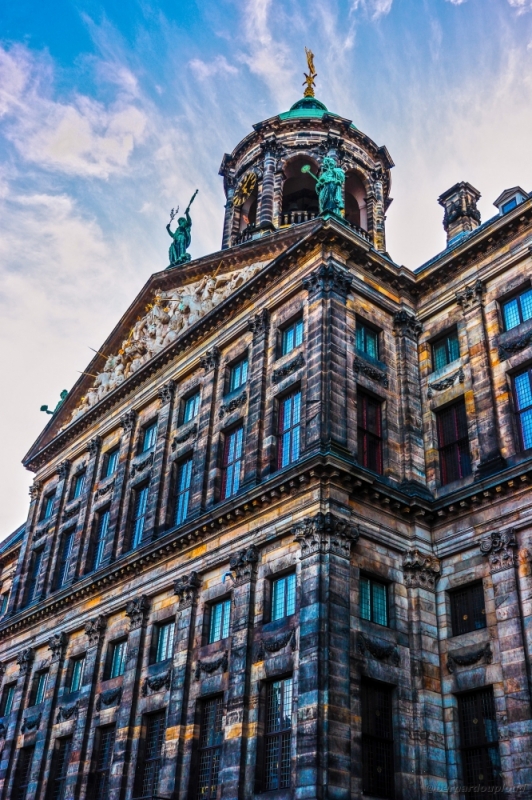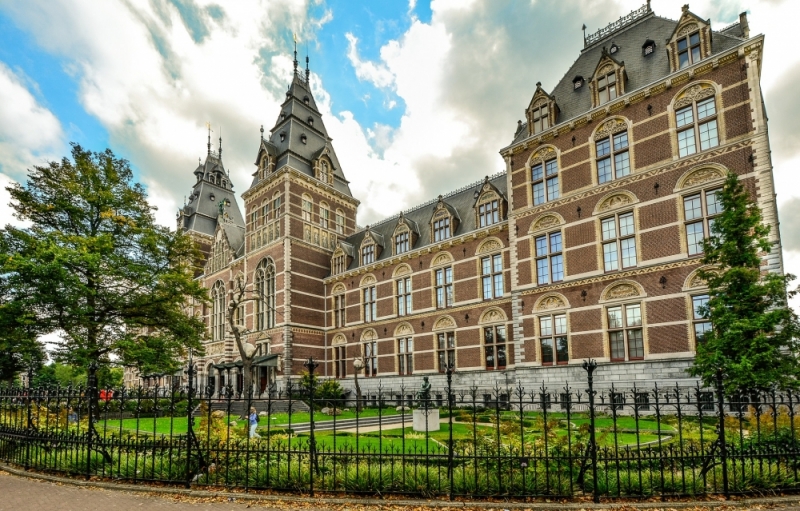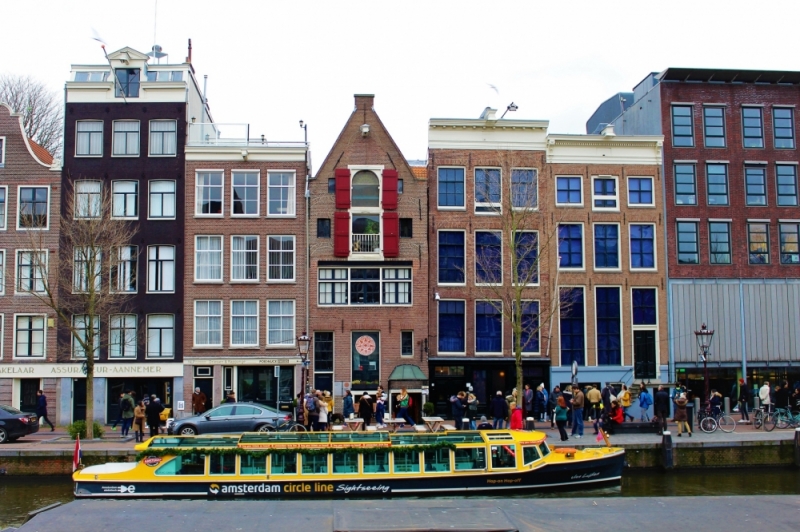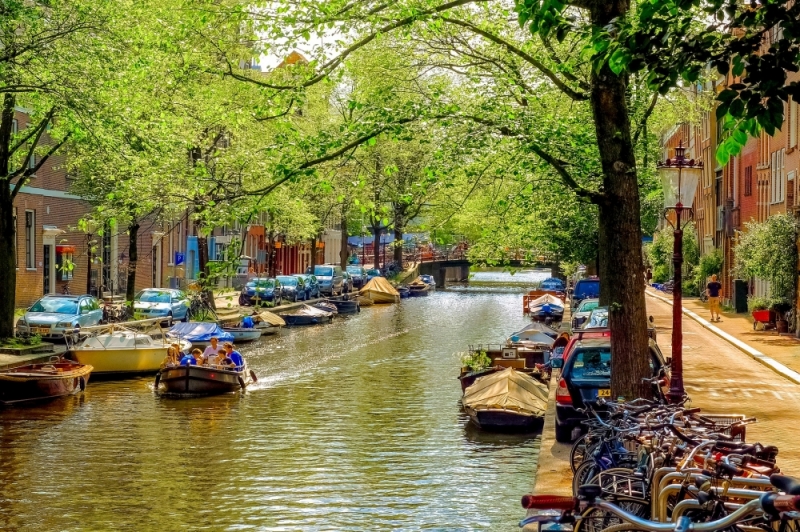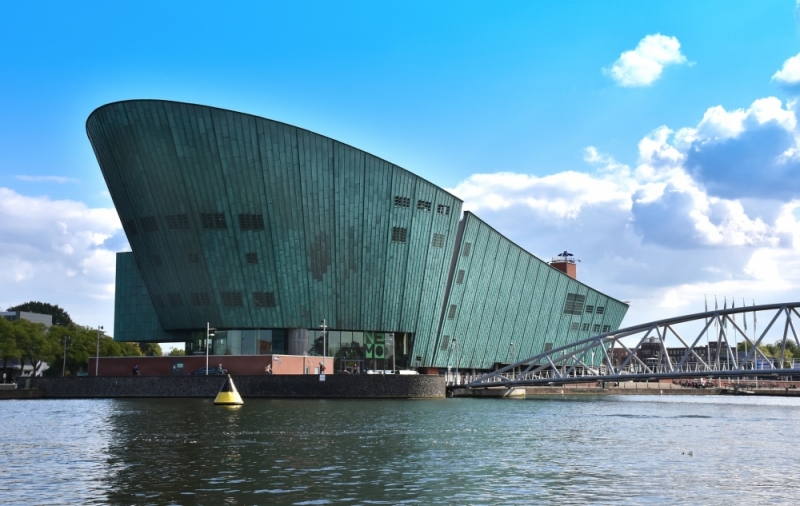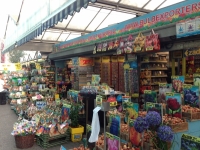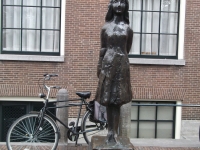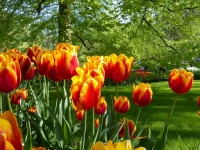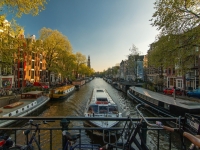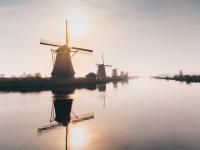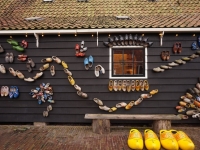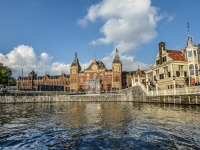Amsterdam, its origins
The name Amsterdam was mentioned for the first time in a document from 1275, and indicated a small mercantile village dedicated to fishing. In ancient times, however, Holland was only a marshy and uninhabited land, with several rivers, including the Amstel river, which flowed into what was once the IJ bay. The city originated near the natural dam of the river, the Dam, towards the end of the 12th century. From there Amstel on the Dam was born, from which the name Amsterdam was formed. Today, in place of the dam, there is the city's main square, known as Dam Square. Amsterdam became a city at the beginning of the 13th century, when the bishop of Utrecht, Gwijde van Henegouwen, gave it the civic title. The city, in that period, moved from the center around the dam, bastions were built and canals dug. In 1358 it was part of the Hanseatic League and began to establish itself as a center of trade in Northern Europe. The Netherlands was inherited by her grandmother Maria, of the Duchy of Burgundy. Amsterdam, after Lisbon, became the most important port in the world. It was the commercial hub for the sale of grain and weapons and became the center of the trade of spices from India. In 1578 the city joined the front against Spain and the main reasons were: the fight for religious freedom; the defense of the privileges of the dominant classes; the idea of nationalism that was spreading; the strong repression of the Duke of Alba and the imposition of new taxes such as the Centesimo and the Alcabala. Holland defeated the Spanish and became independent thanks also to the support of William of Orange.
In 1609 the Bank of Amsterdam was created, modeled on that of Venice. The 17th century is considered Amsterdam's First Golden Age. It was the era in which the town hall was built in Dam Square and the city was a destination for intellectuals, some of whom were fleeing wars, such as Rembrandt, Spinoza and Descartes. When the Jews arrived, Amsterdam became the hub of the trade in precious stones and metals.
In the 17th century, the Dutch East India Company and the West India Company were created in Amsterdam. The centuries of prosperity came to a halt following the wars with England and with the Prussian and French troops.
In the last decades of the 19th century, along with the industrial revolution, Amsterdam had its second Golden Age and remained neutral during the First World War. Instead, during the Second World War, Nazi troops invaded the territory and on May 10, 1940. For the Jewish people living in Amsterdam, they were hard days. One of the best known victims is Anne Frank.
What see
Amsterdam is a city where the ancient and the modern merge. It is a mix of history and innovation, museums, canals and tulips that you can see in Bloemenmarkt , the only floating market in the world, located near Muntplein , a square that is actually a bridge, the largest in Amsterdam, and cross the Singel canal. Amsterdam, in fact, is made up of a dense network of canals connected to each other by about 1500 bridges, which have earned Amsterdam the nickname Venice of the North.
nOnce you arrive in the Dutch capital, we advise you to start your tour, starting from Dam Square , crossed by pedestrians, trams, tourists and bicycles. Dam Square is the heart of the city, full of markets and street artists that crowd this beautiful square at any time of the year. Here overlook the Royal Palace, Koninklijk Paleis , and the new church, Nieuwe Kerk which actually dates back to the 15th century. At the center of the square is the Nationaal Monument , a 22m obelisk built in 1956 to commemorate the fallen of the Second World War.
Guests of the various buildings overlooking Dam Square, there are important sites, such as the famous MadameTussauds wax museum or the De Bijenkorf shopping gallery, which has been located there since the 19th century where you can find the big names in luxury.
nOnce you arrive in the Dutch capital, we advise you to start your tour, starting from Dam Square , crossed by pedestrians, trams, tourists and bicycles. Dam Square is the heart of the city, full of markets and street artists that crowd this beautiful square at any time of the year. Here overlook the Royal Palace, Koninklijk Paleis , and the new church, Nieuwe Kerk which actually dates back to the 15th century. At the center of the square is the Nationaal Monument , a 22m obelisk built in 1956 to commemorate the fallen of the Second World War.
Guests of the various buildings overlooking Dam Square, there are important sites, such as the famous MadameTussauds wax museum or the De Bijenkorf shopping gallery, which has been located there since the 19th century where you can find the big names in luxury.
Amsterdam is a city full of museums, so many to be collected in a square, the Museumplein where you will find the most important Dutch museums. The first and perhaps also the best known is the Van-Gogh Museum . Completely dedicated to the Dutch artist, this museum houses a vast collection of the artist's works, as well as documents, drawings and letters exchanged with his brother Theo, which give visitors to the museum the opportunity to discover their emotions. who accompanied the tormented artist, from when he was a child until his death. In this museum you will find some of Vincent Van-Gogh's most important works, such as "The Potato Eaters" , "Vincent's Room in Arles" and "The Sunflowers" .
Another museum not to be missed is the Rijksmuseum , an imposing museum, the most important in the Netherlands, which has housed, since 1800, the largest collection of Flemish art in the world. Worth seeing is definitely "The night patrol" by the famous artist Rembrandt, of which there are also other beautiful works. The third museum, noteworthy is the Stedelijk Museum , the museum of modern and contemporary art in Amsterdam, where you will find works also by Marc Chagall and Pablo Picasso, going as far as Pop art and industrial Design. The architecture of the building has made this museum an icon of modernity.
Anne Frank house
In addition to its coffee shops and the red light district, Amsterdam is also famous for being the city where Anne Frank and her family took refuge during the Second World War. The Franks, together with another Jewish family, the Van Pels, lived from 1942 to 1944 in a building located in the Jordaan district, in the heart of Amsterdam, at Prinsengracht 263-267 . During the visit in the house-museum , you can relive what were the days of hiding lived by Anna and her family and told in the famous Diary. The rooms, despite the various renovations over the years, have been kept identical to when the girl lived here and arriving at the rooms at the top of the building, find her room where Anna had posted photos of famous actresses on the walls, as they did and all the girls of her age still do. Visiting the Anne Frank house will be an experience that will take your breath away. Thanks also to audio and video elements, you will be able to relive all the worries and fears of Anna and her fellow prisoners. You will find that, in fact, although not in a concentration camp, Anna and her family were already prisoners, having to live in silence and without making noise, to avoid being discovered. The only friends he could trust were Miep Gies , secretary to Anna's father, and her husband Jan, who despite knowing the risks they ran, along with two other collaborators, Frank Kugler and Kleiman, helped Otto Frank and his family to hiding until the day they weren't deported.
Jordaan and Vondelpark.
As previously mentioned, Jordaan is one of the main districts of Amsterdam, the true heart of the city. The symbolic district of the Flemish golden century where some of the most famous Dutch personalities lived, such as the painter Rembrandt, whose house, the Rembrandthuis , can be visited. the philosopher Cartes and the poet Vondel to whom the famous Vondelpark is dedicated. This neighborhood, which in the past had been a workers' neighborhood, is today one of the richest neighborhoods in the city, with beautiful terraced houses and small bridges and still very popular shops, cafes and galleries. Vondelpark is the green heart of the city. Over 45 hectares of park where you can walk, have a coffee, where there are stages on which numerous artists often perform. Furthermore, for children, there are special play areas and it is possible to meet many parrots, the "collared parakeets" , who with their verses give life to real concerts.
Movida and entertainment
Amsterdam is not just a city of art. In fact, at night, between coffee shops and red light districts, it becomes a transgressive destination.
The red light district, the De Wallen , is a network of paths, in the oldest part of the city, where there are about 300 houses which are real rooms in which prostitutes welcome their customers. The red lights that illuminate these rooms give the neighborhood a nickname. Here, in addition to this "attraction" you will also find the Museum of Eroticism , sex shops, erotic theaters and coffee shops, where you can legally consume marijuana.
The red light district, the De Wallen , is a network of paths, in the oldest part of the city, where there are about 300 houses which are real rooms in which prostitutes welcome their customers. The red lights that illuminate these rooms give the neighborhood a nickname. Here, in addition to this "attraction" you will also find the Museum of Eroticism , sex shops, erotic theaters and coffee shops, where you can legally consume marijuana.
However, if you want to stay outside the De Wallen, just move to one of the many squares in Amsterdam, where you will find many characteristic places. For example, Rembrantplein , where the artist's bronze statue is in the center, is a meeting place for everyone. Here you will find cafes, restaurants and discos.
Among the many, we recommend a couple of restaurants where you can try typical Dutch cuisine, including Frank's Smoke House, De Silveren Spiegel, Cafe Sonneveld or the Pantry. Not to be missed is the Dutch cheese, typical of the culinary tradition of Holland. In Amsterdam, the most famous cheeses are Gouda, Jonge and Oude. If, on the other hand, you want something sweet, we suggest you try the Speculoos, typical Christmas sweets, made up of cinnamon, ginger, cardamom, pepper, nutmeg and cloves.
Dried or raw herring is another typical dish of Northern Europe, and it is also part of Dutch street food: in fact you can find broodje haring, the typical herring, gherkin and onion sandwiches in every corner of the city.
Another fish-based dish, very popular in the city is the Kibbeling, based on fried cod and served with herb, garlic and lemon mayonnaise. There is also Stamppot, made with smoked sausage, mashed potatoes and seasonal vegetables (such as sauerkraut, cabbage, carrots and onions). Also try the bitterballen, flavored beef meatballs which are then fried and accompanied by mustard.
If you want to stop for a beer or a few drinks, the most famous pubs and coffee shops where tourists and locals gather are the Brews and Tales, Amsterdam Craft Beer Tour, the Happy Feelings Coffeeshop, the Cafe Pollux, or even the Cafe Hill Street Blues.
You can also take an evening cruise on the canals and enjoy the night colors of the city, or visit the well-known red light districts or the ice bar, better known as the Ice bar.
Dried or raw herring is another typical dish of Northern Europe, and it is also part of Dutch street food: in fact you can find broodje haring, the typical herring, gherkin and onion sandwiches in every corner of the city.
Another fish-based dish, very popular in the city is the Kibbeling, based on fried cod and served with herb, garlic and lemon mayonnaise. There is also Stamppot, made with smoked sausage, mashed potatoes and seasonal vegetables (such as sauerkraut, cabbage, carrots and onions). Also try the bitterballen, flavored beef meatballs which are then fried and accompanied by mustard.
If you want to stop for a beer or a few drinks, the most famous pubs and coffee shops where tourists and locals gather are the Brews and Tales, Amsterdam Craft Beer Tour, the Happy Feelings Coffeeshop, the Cafe Pollux, or even the Cafe Hill Street Blues.
You can also take an evening cruise on the canals and enjoy the night colors of the city, or visit the well-known red light districts or the ice bar, better known as the Ice bar.
If, on the other hand, you are in the company of children or you are animal lovers, we recommend you to visit the Artis , the largest zoological garden in Holland which houses about 8200 animals of 786 different species.
Amsterdam is also the capital of Haineken, the famous beer brand, which has its origins here. We therefore advise you to take the tour known as the Heineken Experience. It is a real journey inside the factory where one of the most famous beers in the world is produced.
In addition, Amsterdam is famous for windmills. Arrange a tour to see the windmills, tulips and clog factories, which are located in the villages all around the big city. You will not regret anything in the world
In addition, Amsterdam is famous for windmills. Arrange a tour to see the windmills, tulips and clog factories, which are located in the villages all around the big city. You will not regret anything in the world
Climate, curiosity and advice
Climate : in Amsterdam the climate is sub-oceanic, humid and rainy, thanks to the influence of the North Sea, but also of the Atlantic and has a cold winter and a fairly cool summer. The average temperature in January is 3.5 ° C while that in July is 17 ° C.
Rainfall is frequent throughout the year: the rainiest season is autumn while the least rainy is spring. The best time to visit Amsterdam is from mid-May to mid-September.
Rainfall is frequent throughout the year: the rainiest season is autumn while the least rainy is spring. The best time to visit Amsterdam is from mid-May to mid-September.
Curiosity : if you have been impressed by the tall and narrow houses, you must know that their peculiar shape has its own reason. In fact, in the past, in Amsterdam there was a complex system of taxation according to which the tax varied according to the width of the facade. The wider the facade, the more the owner had to pay. There are also extreme situations such as the building at number 7 of the Singel, one of the narrowest houses in the world, about 2 meters wide.
Among the many buildings in the beautiful Dutch capital, there is one that is noteworthy, also because it was designed by our Renzo Piano. We are talking about the NEMO which is the largest science center in the Netherlands.
Tips : we advise you to give yourself a visit out of town and visit Holland in the seventeenth and eighteenth centuries. We are talking about Zaanse Schans, a jewel that has remained intact over time which is about 16 km from Amsterdam, full of windmills, a farm for the production of cheese and many characteristic shops, where you can taste typical biscuits, ice creams produced in the place and much other.
You can reach it in just 40 minutes by bus or train from Central Station and you will spend a truly unique day.
You can reach it in just 40 minutes by bus or train from Central Station and you will spend a truly unique day.



